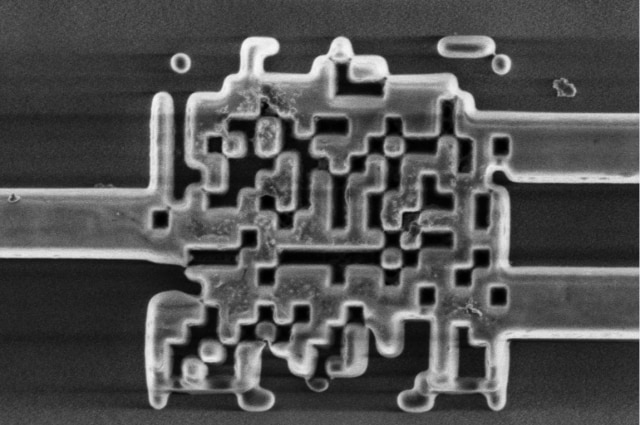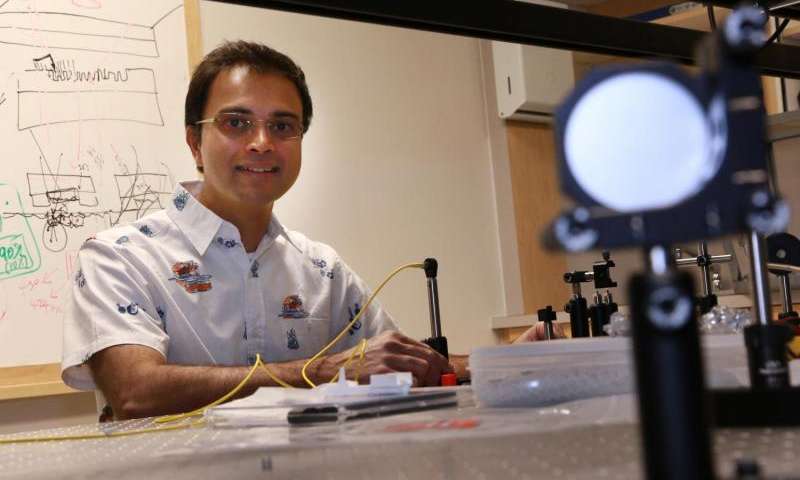Fluent in the language of light
When you access the Internet from your computer, light particles (photons) that contain data bounce along a fiber-optic cable, ready to relay that cute cat video to your screen. When the photons reach your computer, they need to be converted to electrons so that your computer can understand the data. This is just like when two lanes merge to one on the freeway and cause traffic jams. Bottlenecking can occur as quick photons wait to transfer their data to relatively sluggish electrons.
Now, a team of scientists at The University of Utah has created a microscopic silicon photonic chip that takes an incoming beam of light and spits out two beams of light. Previously such separation would have required time and power-consuming electronics or if photonics devices were used they would have been much larger and so much harder to integrate onto a chip.

These new microchips do away with converting photons to electrons by working exclusively with light particles and since photons are the fastest-moving particles in the known universe, this has the potential to make computers incredibly fast.
World’s smallest. And environmentally beneficial.
The ultracompact beamsplitter is 2.4 by 2.4 microns (millionth of a meter). For reference, a bacterium is around 2 microns. Since the chips shuttle photons along instead of electrons, devices would create less heat and need less power to run and have a longer battery life. Also, the size of the chip means that fewer raw materials are needed to make it and the techniques to print the chip use mature, preexisting processes in silicon electronics.
“This means that we can exploit the vast existing manufacturing infrastructure to enable integrated photonics,” says Rajesh Menon, Associate Professor at The University of Utah. “Data centers today consume over 2% of the total global electricity. Reducing power consumption in data centers and other electronics can go a long way to reduce our CO2 emissions and stem global climate change.”

The team at Utah has ambitions to create a library of ultra-compact devices that can then be all connected together in a variety of different ways to enable both optical computing and communications.
“I believe that these devices will usher in unpredictable, but unbelievably exciting applications”, says Rajesh Menon.
Under development
The first supercomputers using silicon photonics – already under development at companies such as Intel and IBM – will use hybrid processors that remain partly electronic. Rajesh Menon believes his beamsplitter could be used in those computers in about three years. Data centers that require faster connections between computers also could implement the technology soon.
Multiple exaFLOPs optical computer on your desk. By 2020?
Optalysys, a UK technology company, says it is on-target to demonstrate a novel optical computer, which performs calculations at the speed of light. If all goes to plan, Optalysys will put an exascale supercomputer on your desk by 2020.
Advancements in liquid crystal technology now permit numerical data to be dynamically entered into an optical system at high speeds and resolutions. In April, the company announced that they have successfully developed a demonstrable prototype that can process mathematical functions optically in a patented, scalable, lensless design. Optical processing systems will “turbo-charge” existing computers by performing processor-intensive tasks at much faster rates and with a significant reduction in energy consumption. The portable prototype, with a footprint similar to a desktop computer, achieves a processing speed equivalent to 320 gigaFLOPs.
“Optalysys’s initial products will launch in 2017 and are expected to enable existing computers to achieve HPC-levels of performance up to an equivalent processing rate of 9 petaFLOPs – comparable to the 5th fastest computer in the world today. Following that we plan to pursue the design of larger systems capable of achieving multiple exaFLOPs by 2020”, says Optalysys Chairman, James Duez.
https://www.youtube.com/watch?v=T2yQ9xFshuc&list=PLQK8lSHQrWKqKCX3Gmg9vNVuSn93WNYPS
























